By Adam Woodward
Copyright euroweeklynews

The US federal government has just slammed into a partial shutdown beginning at midnight on October 1, 2025, as Congress failed to pass a funding bill before the fiscal year 2026 deadline.
What this means is that non-essential services are shuttered, and the nation is bracing for disruption in a bitter partisan clash that’s left lawmakers pointing fingers.
This is the first shutdown since the record-breaking 35-day stalemate from December 2018 to January 2019, provoked by a fight over the Mexico border wall funding. Today’s crisis will disrupt millions of lives, stall the economy, and risk deepening political divides ahead of midterm elections. With President Trump holding down the shutdown button to push workforce cuts, the stakes for the US economy are sky-high.
What sparked the US Government shutdown?
The shutdown originates from a congressional deadlock over spending. Republicans, who hold slim majorities in both chambers, pushed a continuing resolution (CR) to fund the government until November 21 at 2025 levels, which include steep Medicaid cuts from the July 2025 “One Big Beautiful Bill Act”. Democrats are demanding protections for health care and Affordable Care Act tax credits, which expire in 2025, and have rejected the plan. A Senate vote on the GOP’s CR fell short of the numbers needed, 60 votes, and secured only three Democratic supporters. Trump’s directive to agencies to issue layoff notices for “non-essential” workers during the lapse has heated accusations of political retaliation, with Democrats labelling it a “Trump tantrum”.
US Government shutdown – what happens next?
Consequences are immediate and far-reaching. About 800,000 federal workers are now furloughed without pay, while 2 million “essential” staff, including military personnel, work unpaid, with delayed October pay cheques. National parks and Smithsonian museums face closures, air travel sees delays from furloughed FAA staff, and IRS operations slow, risking tax refund delays. Programmes like WIC for low-income families could collapse by mid-October, and the economy will take a daily hit exceeding $1 billion. Essential services like Social Security and veterans’ benefits continue uninterrupted.
What’s next? Senate Republicans plan to hammer Democrats with repeated CR votes starting October 2, banking on public pressure to force a deal. But with both sides with their heels dug in (Democrats demanding health care restoration, Republicans eyeing spending restraint and firings), analysts and pundits predict a weeks-long standoff. Bipartisan talks at the White House have made no breakthroughs, and with elections looming, a quick resolution looks unlikely. The United States waits as Washington’s gridlock deepens.



